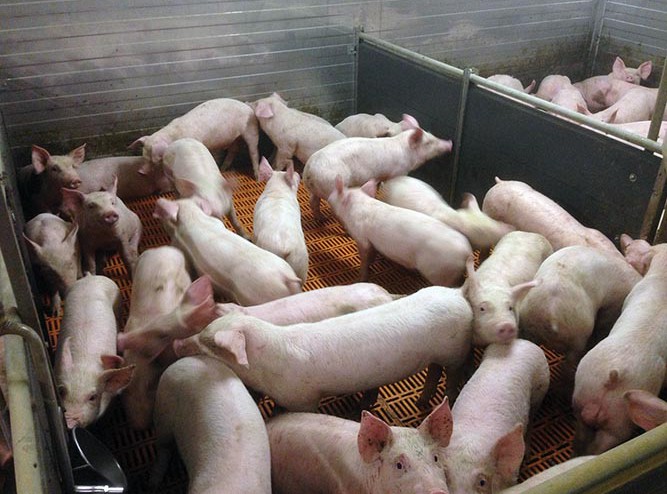
After milk and beef, pig production is the biggest sector of the agricultural industry with the value of pig meat exports reaching over €500 million last year.
Employment in the pig sector accounts for at least 1,500 labour units on farms, with the total number employed in associated sectors such as pig meat processing, feed manufacture, haulage and services being estimated at 8,000.
There is an estimated 290 commercial sow herds in Ireland and the June 2013 CSO Livestock Survey reported that there are 1.55 million pigs in Ireland, 147,500 breeding sows and 1,404,600 finishing stock. This gives and average herd size of 508. The UK is the main Irish pigmeat market receiving over 45% of our total pigmeat exports, 23% was exported to Continental EU and the remaining 32% went to international markets.
For disease control purposes, only persons registered with the Department of Agriculture and issued with a valid pig herd number are allowed to own or trade in pigs. Cork, Tipperary, Cavan and Monaghan are the most significant counties in terms of commercial pig farm numbers.
Having survived the peaks and troughs of the pig price cycle without any subsidy or protection from market forces, those that remain in pigs in Ireland tend to be highly efficient and technically excellent. The best producers achieve output of 28-30 pigs per sow per year, a figure that compares very well internationally. Output has grown by 9% in recent years, due to higher numbers but mainly better genetics and feeding.
However, the reality is that pig farming has moved from being a common feature of thousands of farmyards to a highly specialised intensive operation.
For this month’s edition of Irish Tractor & Agri, we profile the Cork based Moloney Pig Farm and speak to owner Raymond Moloney about what it takes to run a piggery on a daily basis.
Consumption of pork in Ireland goes back generations as potatoes, bacon and cabbage remain today the ‘national dish of Ireland and, while no longer ubiquitous, forms the standard fare of many Irish dinner tables and foodservice outlets. A traditional Irish breakfast consists of sausages, black and white pudding, bacon and fried eggs.
Moloney Pig Farm run a 400 sow integrated pig unit from their premises in Ballinspittle, Co Cork, this family run business also harvest around 300 acres of grain annually.
“We would be kept busy to say the least,” admitted Raymond. “When I was growing up, we had a small bit of ground and we had a few pigs on it. When I would come home from national school, I would go out and tend to the pigs.
“By 1975, I had 40 sows and it was then that I decided to concentrate solely on pig farming and we’ve built the business up from there. We now have over 400 sows here.”
Raymond admitted that pig farming can be a very fickle industry given the unstable price of pig meat. “The price is very much up and down and although we continue to place a huge investment in the business, it is very hard to know what is around the corner in this game.
“We sell all our pigs to Staunton Food Ltd who supply quality pork and bacon products to both the domestic and export markets with 200 pigs leaving the premises every week.”
Raymond admits that there has been massive changes to the pig farming industry over the years, all of which costs great investment.
“Animal welfare is a massive part of the business now and to be compliant with all the relevant legislation, there is a need to invest heavily. With the support of an Animal Welfare Grant, we made a huge investment in 2013 to ensure our facilities were up to the required standards.”
Moloney Pig Farm is a family run business as Raymond along with two of his three sons Killian and Gavin both working on the farm on a daily basis, while the third son, Gary, helps out during busy times.
“There are two parts to the farm and that’s the pigs and the grain. Gavin looks after the grain, while Killian and a full time pigman, Des Murray look after the pig breeding unit, while I look after the pig finishing unit as well as helping out Gavin at the grain.
“We grow and harvest predominantly spring and winter barley as well as a small bit of spring wheat. Our two enterprises work well together with the grain being an outlet for the pig slurry, while the slurry has removed the need to apply any P’s or K’s to the tillage ground and it also greatly reduces the nitrogen requirements for the grain which is a big saving on costs. Depending on the time of year we can be very busy, but we are always kept going doing something”
Despite this, Raymond revealed that the family is steeped in the GAA as his wife Imelda and himself have always ‘downed tools’ and brought the lads to games as they line out for the Courcey Rovers club.
As well as Raymond’s three sons lining out for Courcey Rovers Senior hurlers, the three girls in the family have all played senior camogie for Courcey Rovers.
While one of the daughters, Rachel will be well known in camogie circles as she won five All-Ireland senior camogie titles with the Rebels while also being honoured with All-Stars on three occasions as well.
“Imelda and I said years ago that we would always put the GAA first with regards to the kids playing. Life is too short to be working 24/7, so we do our best to work around that and we’ve no regrets in doing that.”
Moloney Pig Farm
Ballinspittle,
Co Cork.
Taken from Irish Tractor & Agri magazine Vol 2 No 6, November 2014